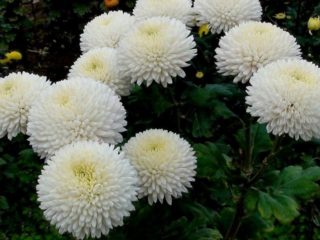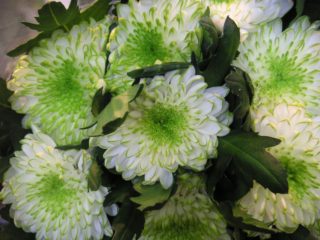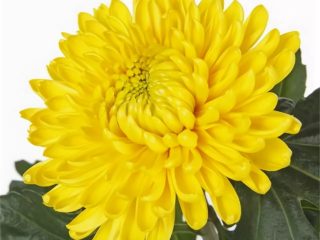Content
Planting chrysanthemums in the spring should be carried out on time and in accordance with all the rules, otherwise in the current season flowering will be scarce or will not happen at all. The subsequent competent post-transplant care is also important, because only a well-groomed plant is at the peak of its decorative effect.
When is it better to plant chrysanthemums - in autumn or spring
Like the vast majority of horticultural crops, it is preferable to plant chrysanthemums in the ground on the site in the spring. In this case, the flower has a lot of time ahead in order to have time to fully take root and get used to the allotted place. The plant, planted in spring, actively builds up the ground green mass, gains strength, and by the end of summer it enters the flowering phase.
It is permissible to plant chrysanthemums in the fall, but only as an exception. Recently planted bushes are still too weakened to adequately endure wintering, therefore they often freeze out. In addition, some non-frost-resistant varieties of chrysanthemums are dug up for the winter and stored in relative warmth (basement, cellar). In the spring they are returned back to the flower bed.
When to plant chrysanthemums outdoors in spring
Although chrysanthemum is considered a cold-tolerant crop, in spring it should be moved into the ground only after stable and sustained warming. Recurrent frosts should be a thing of the past and no longer pose a threat. In the middle lane, including the Moscow region, this time usually falls in the second half of May. In the more northern regions, planting is done a little later - in the first decade of June. In southern latitudes, where spring comes very early, flowers are planted from the beginning of April.
In order for the chrysanthemum to take root in the spring, the soil in the flower bed should warm up well - up to + 12 + 14 ° C. The temperature should be measured at a depth of about 15-20 cm.

Blooming chrysanthemums can be planted in the spring, but you just need to try to minimize their root system
How to plant a chrysanthemum in spring
In order for the chrysanthemum to show itself as much as possible and please with its luxurious flowering, when planting it in the spring, several important points must be taken into account. Without observing these nuances, the decorativeness of the culture can be much lower than expected.
Selection and preparation of the landing site
For chrysanthemums, it is better to choose an open and well-lit area with the sun, because the stems stretch out in the shade, few buds are formed and they are small. The swampiness of this culture is contraindicated, it is the closure of the root system that is considered the most common cause of plant death. Chrysanthemums should be planted in spring on a small hill, where moisture does not accumulate, there is no close occurrence of groundwater. Lowlands and wetlands should be avoided.
Most of all, fertile and well-drained loams and sandstones that do not allow excess moisture to stagnate are suitable for organizing a flower garden.Very poor sandy soils are enriched by the introduction of humus with the addition of a clay substrate. Heavy and clayey soil is lightened and loosened with sand. The site is carefully dug up, while making (per m2):
- nitroammofosk - 35-40 g;
- superphosphate - 20-25 g;
- organic matter (compost, humus) - 3-4 kg.
Landing rules
In order for chrysanthemum seedlings to take root better in the spring and grow faster, they need to be planted on a cloudy or even rainy day. In extreme cases, the morning dawn or evening sunset hours are set aside for planting work.
The algorithm of actions is as follows:
- First, they dig a planting hole with a diameter of about 0.5 m and a depth of about 0.3-0.4 m. If there are several bushes, then between them leave from 0.3 to 0.5 m (depending on the size).
- To improve the drainage of liquid, drainage (3-5 cm) from pebbles or just coarse sand is poured onto the bottom of the dug hole.
- The seedling is lowered into the hole, the roots are spread on the sides.
- Holding the bush, the hole is filled with soil.
- They compact the earth, simultaneously forming a hole for irrigation.
- Water abundantly (3-4 liters per bush).
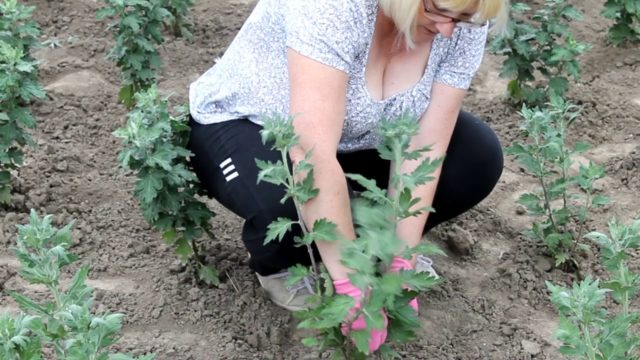
When planting chrysanthemums, the ground around the bushes must be carefully tamped.
Chrysanthemum care after planting in spring
Further care in the spring for planting chrysanthemums should be given special attention. It directly depends on this how abundant and long flowering will be.
Watering and feeding
Since chrysanthemums intensively increase the ground part in spring and early summer, they need to be watered often and abundantly. Usually 3-4 liters are enough once a week. If the weather is hot and there is no natural precipitation, then water is often watered (twice a week). After every good rain or full watering, you need to loosen the ground under the bushes, this will help to avoid the formation of a soil crust, which prevents air from penetrating to the roots.
Approximately 15-20 days after planting, chrysanthemums are fed with nitrogen-containing compounds:
- herbal infusion (1: 8);
- chicken droppings (1:15);
- mullein (1:10);
- urea (10-15 g per bush).
In summer, when buds begin to form, chrysanthemum bushes need fertilizers with an increased concentration of phosphorus and potassium. You can use (per bush):
- wood ash (50-60 g);
- potassium monophosphate (8-12 g);
- superphosphate (15-20 g);
- any complexes (Fertika, Kemira) for flowering crops.
Mulching
To reduce the frequency of watering, planting chrysanthemums should be mulched with cut grass, sawdust, peat, cones, and needles. Periodically, the mulch layer is refilled.
Shaping and pruning
In the spring, almost immediately after planting, it is necessary to start forming the crown of the chrysanthemum bush. The technology of work is different and depends on the specific type of culture. Pinching is most often used when the crown of the shoot is removed during the period of its active growth, but before budding begins. Formation is carried out regularly in several stages, maintaining a sufficient time interval between procedures so that the trimmed bush has time to recover.
Small-flowered chrysanthemums are pinched for the first time in spring to increase bushiness, shortening the tops after 4-5 leaves. For new shoots released from dormant buds, re-pinching is done for 7 leaves. The resulting bush can have about four dozen inflorescences.
Large-flowered varieties, which are often used for cutting, pinch, stopping the growth of the central stem at a height of about 10-15 cm. Then no more than 2-3 strong shoots are left, timely removing all axillary stepsons and lateral buds.
When the seedling outgrows and stretches, it needs to pinch the top of its head. This will speed up the appearance of the lateral processes.
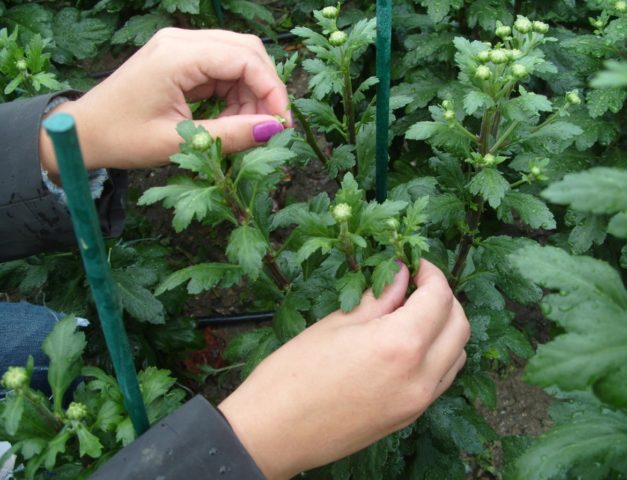
It is recommended to pluck out small buds from spray chrysanthemums - this way the remaining flowers will be larger
Experienced gardening tips
There are some subtleties in planting chrysanthemums in spring and subsequent care for them, which experienced florists are ready to share:
- When decorating a flower bed in spring, it is better to select varieties of chrysanthemums that have different sizes. The tallest bushes are planted in the background, the lowest ones in front.
- For regions with cold climatic conditions, special zoned frost-resistant varieties are more suitable.
- Some especially valuable bushes for the winter are best dug up and transplanted into a container. The remaining ones must be insulated by covering them with spruce branches or any agricultural material.
- In order for the inflorescences to be large and bright, it is necessary to feed the plants in a timely manner.
- This culture does not like soils with a high clay content, because they retain moisture. In the spring, before planting, sand must be added to such soils.
- Well-chosen varieties of chrysanthemums with different flowering periods in spring will allow the flower garden to be beautiful all summer and autumn until the very frost.
Conclusion
Planting chrysanthemums in spring presents no technical difficulties. The key to the success of this event will be a correctly chosen place for laying out a flower garden, its high-quality preparation, as well as a good time for the work and subsequent care of the plantings.

